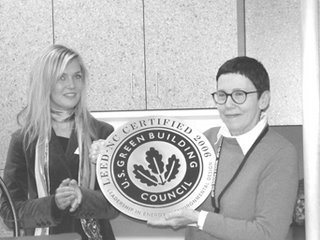 Caption: Jill Isola Johnson, LHB Interior Designer and Sharon Murphy, general manger of Whole Foods Co-op.
Caption: Jill Isola Johnson, LHB Interior Designer and Sharon Murphy, general manger of Whole Foods Co-op.Whole Foods Co-op attains LEED (Green) certification
Whole Foods Co-op not only stocks its shelves with healthy, organic food, its building is good for people and the environment also.
Whole Foods Co-op attained certification by the United States Green Building Councils’ Leadership in Energy and Environmental Design (LEED) It is the first LEED certified building in Duluth, an the third LEED certified building in the state of Minnesota.
Mayor Bergson spoke at the press conference Wed., Oct. 18, The event was held in the community classroom, which is in the basement of the Whole Foods Co-op. “You could have built in a lot of other places and you could have saved a lot of money,” he told the staff and board of the Whole Foods Co-op about their decision to build a “green building.”
The mayor spoke of other green building ideas planned in Duluth which include buildings at the University of Minnesota, Duluth and the DECC. “All of those projects could make us the leader in ecology. I’m proud to be the mayor of an ecomunicpality,” he said.
A certain number of points had to be attained for certification. Points could be gained from these attributes: reusing the site of a former business versus building new, using salvaged materials and equipment versus discarding them, choosing new materials that are long lasting and regional, using galvanized and stainless steel inside and outside, which is long-lasting and requires minimal maintenance, using recycled fiber cement board, rather than strictly plywood, using sheet flooring and countertops made of linoleum, which is made of natural raw materials, using cabinets made of wheat board ,a and annually renewable agricultural material, and using recycled ceramic tile.
After the presentation of the LEED seal (or certificate) the Hillsider toured the Co-op with manager Sharon Murphy and Common Ground representative Jodi Slick. Highlights of this tour included: beams of wood in the entrance were taken from the bottom of the harbor at Ashland, Wisc., flooring which was made of recycled rubber tires, windows which reflect light off the top of the produce cases, counter tops made from pressed sunflower seeds, linoleum which is made of linseed oil, solar panels, tables in the eating room made of old money, special refrigerated case (with no doors which suck the cold air out when opened and can be stocked in the back), and a retaining wall for the hill. The Co-op shares its parking lot with another co-op, the Members Cooperative Credit Union.The offices of the Co-op are in the basement. It includes bike racks for employees to hang up their bikes, a shower and a copier in it own separate room to reduce VOC (Volatile Organic Chemicals.)
